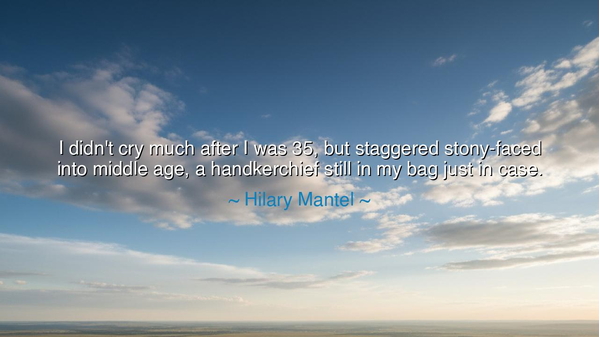
I didn't cry much after I was 35, but staggered stony-faced into
I didn't cry much after I was 35, but staggered stony-faced into middle age, a handkerchief still in my bag just in case.






The words of Hilary Mantel—“I didn’t cry much after I was 35, but staggered stony-faced into middle age, a handkerchief still in my bag just in case.”—are not the lament of weakness, but the confession of endurance. They carry within them the ancient ache of growing older—the transformation of tenderness into fortitude, of sorrow into silence. In her sentence lies the story of a heart that has wept its fill and learned, through long trial, that life’s storms must sometimes be met not with tears, but with a steady gaze. It is the voice of one who has walked through loss, disappointment, and the slow erosion of innocence, and emerged neither unscathed nor undone, but tempered.
Hilary Mantel, the great chronicler of power and mortality in her Wolf Hall novels, was no stranger to suffering. She endured illness, failure, and the long, lonely path of an artist misunderstood before she was acclaimed. Her words reflect the truth that as one matures, the wellspring of easy emotion begins to dry, not because the soul feels less, but because it has learned to bear more. The stony face she describes is not hardness, but armor. It is the shield one forges from years of holding steady through pain, responsibility, and the thousand small compromises that life demands. Yet in that last phrase—“a handkerchief still in my bag just in case”—Mantel reveals that within even the most hardened heart, a quiet fragility endures. The readiness to weep remains, not as weakness, but as remembrance.
This tension between strength and sorrow has echoed through every age. The ancient Greeks told of Niobe, the proud queen who lost all her children and was turned to stone by her grief—yet even as stone, she continued to weep. Her story mirrors Mantel’s insight: that human beings may grow still, their faces unmoved, but the capacity for tears—for compassion, memory, and pain—never vanishes. To survive is not to become unfeeling, but to carry one’s sorrow so quietly that the world mistakes it for calm. Mantel’s handkerchief, tucked discreetly away, is the same symbol—the silent acknowledgment that beneath composure lies the trembling of the soul.
In the journey from youth to middle age, emotion takes on new shapes. In youth, tears flow easily because the world is still surprising—its beauty and cruelty strike without warning. But with age comes recognition. We have seen the patterns of joy and loss repeat; we no longer cry at every hurt, for we know its rhythm. Yet this knowledge does not make us invincible—it makes us wise. We may not sob as before, but the heart remembers how. Mantel’s phrase “staggered stony-faced into middle age” captures this paradox: we move forward not with grace, but with endurance. Life does not demand that we walk beautifully—it only demands that we keep walking.
There is a quiet nobility in such endurance. Consider Eleanor Roosevelt, who, after a youth marked by loneliness and betrayal, transformed her suffering into strength. She became a voice for justice and dignity, rarely displaying emotion in public. Yet in private letters and diaries, one sees the handkerchief still in her bag—the softness she never fully lost. Like Mantel, she understood that to serve others, one must learn to bear pain without constant display. But she also knew that to lose the ability to feel was to lose one’s humanity. Thus, her restraint was never coldness—it was discipline born of compassion.
In this way, Mantel’s quote speaks not only of aging, but of balance—between sensitivity and stoicism, between expression and endurance. It reminds us that growing older does not mean closing the heart, but learning when to open it. To weep is still human, but to live well is to choose one’s tears wisely. There is wisdom in saving the handkerchief “just in case,” for it signifies hope: that though time may carve our faces into masks of composure, the inner spring of emotion remains alive, waiting for the moment when tenderness is needed again.
Let this, then, be the teaching: do not mistake silence for strength, nor strength for the absence of feeling. If you have reached the age when tears come less easily, do not mourn their scarcity; they have transformed into quiet understanding, into patience, into the deep current of empathy that runs beneath speech. But keep, as Hilary Mantel did, your handkerchief close—not only for sorrow, but for joy. For life, in its strange mercy, still offers moments that break the stony mask and remind us that we are gloriously, vulnerably alive.
And so, when you, too, stagger into your middle years—when the world has wearied you, when laughter and pain have both carved their marks upon your face—remember Mantel’s wisdom. Carry your handkerchief as a symbol of readiness: to grieve, to forgive, to rejoice. For to feel, even after all, is not a failure of strength, but the final proof of humanity.






AAdministratorAdministrator
Welcome, honored guests. Please leave a comment, we will respond soon